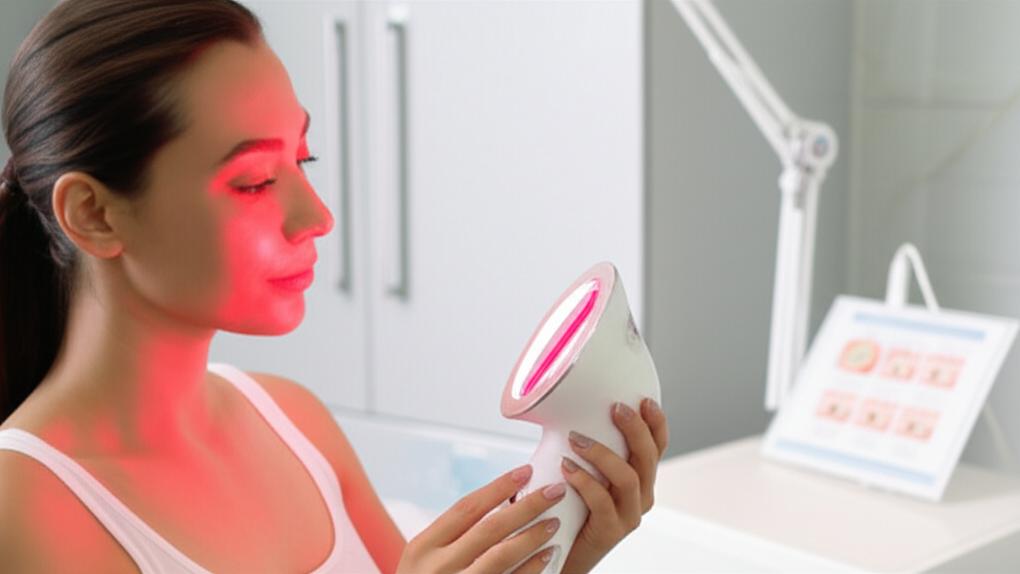A patient sat across from me the other day, her phone held up with a picture of a futuristic-looking mask glowing a vibrant red. “Doc,” she said, a hint of hope and a lot of skepticism in her voice, “what’s the deal with these? Do they really work, or am I just going to look like a superhero for nothing?”
It’s a question I hear a lot in my practice. You see these devices everywhere online, promising to zap away wrinkles and acne. It sounds like science fiction, but the core idea, LED light therapy, has some real science behind it. It’s a non-invasive treatment that uses different wavelengths of light to work on the layers of your skin. It’s not magic, but it can be a useful tool in our skincare toolkit.
What Exactly Is LED Light Therapy?
Believe it or not, the story starts with NASA. Back in the 90s, they were exploring how LED (light-emitting diode) lights could help astronauts heal wounds faster in space by encouraging cell growth. That research paved the way for its use in dermatology.
Today, we use LED light therapy to target a range of skin concerns. The idea is simple: specific colors of light penetrate the skin to different depths, triggering natural processes within your cells. It’s a gentle approach, unlike some other skin treatments. There’s no burning or peeling involved because it doesn’t use damaging UV light.
Understanding the Rainbow of Lights
Different colors do different jobs. Think of it like a team of specialists for your skin. While a professional treatment might combine several lights, the main players you’ll hear about are red and blue.
Here’s a quick breakdown of what each color is thought to do:
| Light Color | What It Does for Your Skin |
|---|---|
| Blue Light | Works on the surface. It’s mainly used to target the bacteria (P. acnes) that cause acne. |
| Red Light | Goes deeper. We believe it helps reduce inflammation and encourages your skin to produce more collagen, which is that wonderful protein that keeps skin looking firm and youthful. |
| Yellow Light | Penetrates a bit deeper than blue light to help with overall skin health and circulation. |
| Near-Infrared Light | This is the deepest-penetrating light, often used for wound healing and reducing inflammation deep within the tissues. |
What Can It Help With? (And What It Can’t)
It’s important to have realistic expectations. LED therapy is a helper, not a cure-all. It’s often used alongside other treatments like creams and facials for the best results.
It may help improve:
- Mild to moderate acne
- Fine lines and wrinkles
- Skin inflammation from conditions like rosacea and eczema
- Sun damage
- Psoriasis
- Wound healing
- Even some precancerous spots called actinic keratosis
However, it’s not the right tool for deeper acne issues like acne cysts, blackheads, or whiteheads. For those, we have other, more effective treatments we can discuss.
In-Office vs. At-Home: What’s the Difference?
This is the big question, isn’t it? The main difference is strength. The devices a dermatologist uses are much more powerful than anything you can buy for your home.
- In-Office Treatment: This usually involves a series of sessions. You might come in once a week for about a month. You’ll lie back, we’ll put protective goggles on you, and a large panel of lights will be placed over your face for about 20 minutes. It’s painless—you might feel a little warmth, but that’s it.
- At-Home Devices: These masks and wands are less intense, so the results will be more subtle. Consistency is key. You might need to use it daily for several weeks to see a modest improvement.
The most important thing with at-home devices is safety. Please make sure any device you consider is marked as “FDA cleared” or “FDA approved.” And always, always wear the provided eye protection.
Is It Safe for Everyone?
Generally, yes. LED light therapy is considered safe for most people and all skin types. Side effects are rare but can include some temporary redness, a rash, or inflammation.
However, it’s not for everybody. We would advise against it if you:
- Are taking medications that make you sensitive to sunlight, like isotretinoin for acne or lithium.
- Have a history of skin cancer.
- Have certain inherited eye conditions.
Before you start any new treatment, whether at a spa or with a device you bought online, it’s always a good idea to chat with a doctor or dermatologist first. We can make sure you have the right diagnosis and that this is a good choice for you.
Take-Home Message
- LED light therapy is a non-invasive treatment that uses different colors of light to address skin issues like acne, inflammation, and signs of aging.
- Red light is primarily for stimulating collagen and reducing inflammation, while blue light targets acne-causing bacteria.
- In-office treatments are more powerful and effective than at-home devices. Results from home masks will be more subtle.
- The treatment is generally safe and doesn’t use UV light, but it’s not suitable for everyone, especially those on photosensitizing medications.
- Always talk to a doctor before starting to make sure it’s the right path for your skin.
There’s no magic wand for perfect skin, but tools like LED therapy can be a helpful, gentle step on the journey. You’re not alone in figuring this out, and we’re here to help guide you.


